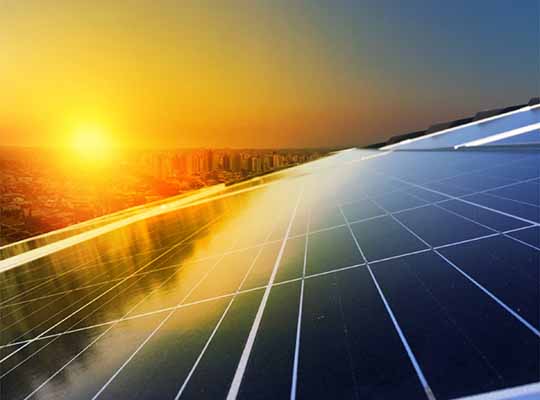Being the fourth sweet spot for the renewable sector, India’s renewable energy sector is blossoming. According to a report in 2019, India enjoyed fifth (5) spot for wind power, fifth in solar power and fourth (4) in cumulative renewable power installed capacity respectively. Making a strong momentum, renewable power generation capacity installed logged a CAGR of 17.33% between FY16-20. The Indian government shall be lauded with taking decisive and pragmatic measure to drive the renewable sector in India. Today, the renewable sector is most desirable sector for investments in India. India has an ambitious dream to reach 15,820 TWh by 2040 in which, renewable sector is set to play an instrumental role. On the other hand, the Government is striving to achieve 227 GW of renewable energy capacity (including 114 GW of solar capacity addition and 67 GW of wind power capacity) by 2022, more than its 175 GW target as per the Paris Agreement. The government plans to establish renewable energy capacity of 523 GW (including 73 GW from Hydro) by 2030.
Market Size
If we look around today compared to the scenario of few years back, there has been a massive plunge in rates of photovoltaic modules. These section fetch depletion have donated to an even more remarkable depletion in the equivalent cost of photovoltaic generated electricity, as archived by the inexpensive price tender for international power purchase agreements (PPAs) for the abiding endow of electricity.
Differentiate to Lazard’s benchmark levelized cost of US$60-142/MWh for electricity from a new coal-fired plant (US$36/MWh marginal cost for subsist plant) and US$112-152/MWh for nuclear, tender for the permanent endow of photovoltaic electricity let fall below US$30/MWh in 2016 and $20/MWh and 2017. It seems only a consequence of schedule before a bid below spectacular US$10/MWh (or 1 c/kWh) is encounter. In spite of the fact that these tender are for the supply of electricity ‘when generated’ rather than ‘on demand’, Snowy Hydro in Australia, by amalgamate with subsisting pumped-hydro storage assets, not long ago reported the potential to supply ‘firm’ solar and wind created electricity, when needed, at AUD$70/MWh (US$50/MWh). Ruthless bids have also been experienced in the US for solar and wind hold up by battery storage (US$36/MWh and $21/MWh respectively, although these charges are let down by a 30% expenditure tax creditor, for wind, making tax credit of up to US$24/MWh).
As of February 2021, installed renewable energy capacity stood at 94.43 GW. By December 2019, 15,100 megawatts (MW) of wind power projects were issued, of which, projects of 12,162.50 MW capacity have already been awarded2. Power generation from renewable energy sources in India reached 127.01 billion units (BU) in FY20.
With a potential capacity of 363 GW and with policies focused on the renewable energy sector, Northern India is expected to become the hub for renewable energy in India.
The inexpensive bids have been imminent not merely due to the module price depletion distinguished above, but also due to more commendatory funding circumstances. Before 2016, it was burdensome to allure commendatory engrossment rates for speculation in photovoltaic systems due to their relative novelty, with lower rates for more entrenched automation. As the conviction in the technology’s potentiality to provide has get bigger and fossil-intensive investments increasingly sprint the likelihood of flattering stranded assets, the circumstances alter. Capitalizing for some of the additional ruthless photovoltaic bids has been through green bonds, fully read by shareholder contended with low- output. These interchanges nevertheless throw back real market intensity in play that are relevant to have a growing collision on the capability to financial affairs stick out in the future. Supported by the above cost depletions, the annual photovoltaic market has get bigger quickly and frequently over the past two decades, increasing from 252 MW yr−1 position in 2000 to 109 GW yr−1 in 2018, per annum aggravate increase of 40% yr−1 over this period. Since 2010, the compounded growth rate has relaxed to 25% yr−1. If extension can be succoured in the 25%–40% yr−1 range for a compact extensive, yearly installations will reach 1 TW yr−1 foregoing over the coming years, between 2025–2028. The consequence of this magnitude of photovoltaic installation, originally published in 2015. In spite of the best endeavour of the four signigicant ejectors, the total CO2 discharge budget permissible for compeling worldwide temperature stand up to 2 °C appears likely to be worn out by these four alone towards the end of the next decade.
Investments/ Developments
According to the data released by Department for Promotion of Industry and Internal Trade (DPIIT), FDI inflow in the Indian non-conventional energy sector stood at US$ 9.83 billion between April 2000 and December 2020. More than US$ 42 billion has been invested in India’s renewable energy sector since 2014. New investment in clean energy in the country reached US$ 11.1 billion in 2018. According to the analytics firm British Business Energy, India ranked 3rd globally in terms of its renewable energy investments and plans in 2020.
Road Ahead
The Government is committed to increased use of clean energy sources and is already undertaking various large-scale sustainable power projects and promoting green energy heavily. In addition, renewable energy has the potential to create many employment opportunities at all levels, especially in rural areas. The Ministry of New and Renewable Energy (MNRE) has set an ambitious target to set up renewable energy capacities to the tune of 227 GW by 2022, of which about 114 GW is planned for solar, 67 GW for wind and other for hydro and bio among other. India’s renewable energy sector is expected to attract investment worth US$ 80 billion in the next four years. About 5,000 Compressed Biogas plants will be set up across India by 2023.
It is expected that by 2040, around 49% of the total electricity will be generated by renewable energy as more efficient batteries will be used to store electricity, which will further cut the solar energy cost by 66% as compared to the current cost. *Use of renewables in place of coal will save India Rs. 54,000 crore (US$ 8.43 billion) annually3. Renewable energy will account for 55% of the total installed power capacity by 2030.
As per the Central Electricity Authority (CEA) estimates, by 2029-30, the share of renewable energy generation would increase from 18% to 44%, while that of thermal is expected to reduce from 78% to 52%.
According to the year-end review (2020) by the Ministry of New and Renewable Energy, another 49.59 GW of renewable energy capacity is under installation and an additional 27.41 GW of capacity has been tendered. This puts the total capacity of renewable energy projects (already commissioned or in the pipeline) at ~167 GW.
The Government of India wants to develop a ‘green city’ in every state of the country, powered by renewable energy. The ‘green city’ will mainstream environment-friendly power through solar rooftop systems on all its houses, solar parks on the city’s outskirts, waste to energy plants and electric mobility-enabled public transport systems.
10 Green Technologies that will Change the World
Every day we hear about a green future. But some way or another, that future seems to be continually detained or strenuous to put into locution or resemblance. Where are the specimen of the new green technologies? Physical implementation, that make us nightmare that the oft-mentioned win-win feature of green technologies will literally come to achievement?
In this write-up I have cool-headed samples of signified green technologies / products that clasp substantial assurance concerning lowering our footmark on our globe.
1. Sunlight Transport
We know very well that the pre-eminent way to rescue carbon emissions is to save power. What if we could light up unflawed structure with just sunlight? This is what the Swedish company Parans has been enlarging. Their technology “Sunlight Transport” is a passive system that channels sunlight from an superficial origin and transports it through fibre optic cables to illuminate light-deprived rooms. As a result, energy consumption during daytime is zeroed.
The sunlight discharging luminaries gaze and work almost like a normal lamp, giving off medium light. Parans’ system can spread light in a range of customized ways: over a sizeable plane, pointed at the roof (which gives an illusion that the light comes through an open shaft), or onto a large wall area like a waterfall. The light interchanges as sunlight outside changes, permitting people even in the unlighted rooms to revive a link with the natural cycle outside. Parans recommend that the fibre optic cables can lead sunlight a hundred metres inside a building while contracting maximum light potency.
As the indoor lighting is presuming by a passive system there is no energy exhaustion — during aurora hours that is. During the twilight, the system must be restore by a regular artificial setting.
2. Plastic Roads
Recall the floating waste mainland in the Pacific? Well, visualize if we could seize all that plastic to sustain our road infrastructure. Well, this likelihood actually subsists, and they are called “Plastic Roads”.
In terms of plastic roads technology we have two options: either they can be made completely of plastic or mixed together with concrete. The erstwhile is the most common. The 100% plastic diversity consists of prefabricated, hollow, modular elements made from consumer waste plastics. There is no concrete in the mix. This product, duly called PlasticRoad, is still in the affirmation phase.
The developer has just affirmated the product in two 30-metre stretches of cycle track in the Dutch towns of Zwolle and Giethoorn. Observing is on-going right now to acknowledge its long-term impact on the local environment. If fortunate, PlasticRoads can also significantly lessen the carbon footprint (50 to 72%) of traditional road construction thanks to longer senility and trimming of transport movements involved in its construction.
Conclusion
As some of these technologies are still in an affirmation phase they have not been very detectable. However, they do offer a narrow sighting of how exciting a low carbon future can actually be. How astonishing would a city filled with green walls and roofs be?
Of course, like any new technology, together with appraise superiority there are always stumbling block. Yet, as at the start of the steam-powered revolution, only by research in real conditions we can promote into greener innovations. What about you? Do you use any of these green technologies? How have they improved your life or reduced your recurring expenses?

















